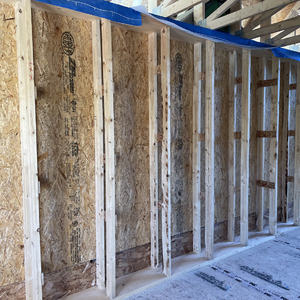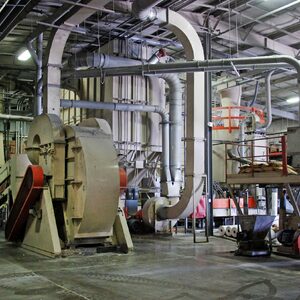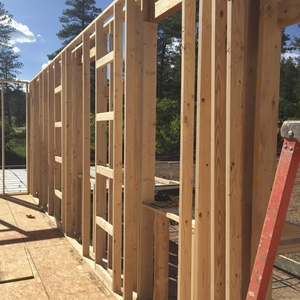
Image Credit: Patrick McCombe
Insulating any building can be a challenge, but the nonprofit energy-efficiency and weatherization company I work for, Community Environmental Center, frequently insulates old houses being rebuilt for residential group homes and elderly housing in New York City. These skilled-care buildings, like the one shown in these photos, are crammed with pipes, ducts, and wires, so they’re tough to insulate. They’re also located in dense urban neighborhoods that can be busy and loud.
For all these reasons, we use damp-spray cellulose insulation in the majority of our open-wall insulating projects. Damp-spray cellulose fills cavities without voids, and it covers pipes and wires without gaps, creating a house that according to the Cellulose Insulation Manufacturers Association is 30% to 40% more effective at stopping air infiltration than a similar house insulated with fiberglass batts installed in the typical manner. The density and air-sealing qualities of damp-spray cellulose also create an effective sound barrier (STC44) that makes these buildings far quieter inside than their surroundings would lead you to expect.
Treated with borates, cellulose is fire resistant and unattractive to vermin. We often demonstrate its fire resistance to skeptical clients by using a propane torch to heat a penny on a small pile of cellulose insulation. Ultimately, the penny melts, but the cellulose fibers turn black without burning. Cellulose also has low embodied energy and installs quickly. We can spray a 3,000- to 4,000-sq.-ft. house in one day with a three-person crew. Depending on the building’s complexity, that can cost from $2.50 to $3.50 per sq. ft. of living space.
Given its attributes, the Natural Resources Defense Council has called cellulose insulation made from recycled paper “the least polluting and most energy-efficient” insulation in use today. Unfortunately, damp spray can’t be installed overhead (in cathedral ceilings, for example), so for these areas, we…
Weekly Newsletter
Get building science and energy efficiency advice, plus special offers, in your inbox.

This article is only available to GBA Prime Members
Sign up for a free trial and get instant access to this article as well as GBA’s complete library of premium articles and construction details.
Start Free TrialAlready a member? Log in















28 Comments
Dense-Packed Cellulose vs. Damp-Sprayed Cellulose & Dust
I will break ground on my new home in 6 months. All barriers (Water, Air, Vapor & Thermal (R-30)) will be on the outside of the sheathing and I'm going for 0.1ACH50. My builder feels that the use of dense-packed cellulose, and presumably damp-sprayed cellulose, results in a dusty home over the life of the home as dust from the cellulose enters the interior environment. Would you please comment on the matter of dust for both of these product applications.
Also, aside from the matter of dust, Would you comment on the comparative Advantages/Disadvantages of Dense Packed Cellulose versus Damp Sprayed Cellulose.
Thanks.
nonsense
Cellulose is contained in walls and/or above ceiling. No dust issues. We've been using it for 30+ years now and never had a complaint.
Dense vs Damp not really a lot of difference in my book. just two ways of accomplishing the same thing. Others may provide more insight though.
Your builder is simply wrong. (response to Tec Cummings)
"My builder feels that the use of dense-packed cellulose, and presumably damp-sprayed cellulose, results in a dusty home over the life of the home as dust from the cellulose enters the interior environment."
The only way for dust to enter the interior environment is if there are SIGNIFICANT air leaks. If your builder's methods are that poor, you should hire somebody else!
Damp sprayed cellulose isn't as inherently air-tight as dense packed. When dense packing it's under considerable air pressure, which forces the fiber into every possible air-leak path, at least partially blocking it. With damp spray it sticks to what it hits, but isn't dragged along by an escaping stream of air into every crack & hole.
But the adhesives in damp spray bind the materials together, so there isn't really much dust to escape even if iit turns your builder IS the hack that he implies he is, leaving multiple & large air leaks for the dust to escape into the conditioned space.
The advantage to damp spray vs. dense pack is primarily cost- it's slightly less material, and it installs more quickly for lower labor costs.
The advantage to dense pack is lower overall air leakage. While damp-spray might be 30-40% tighter than an batt-insulation job, dense packing is more like 90%+ tighter.
But air sealing is not the job of insulation, which can at-best only tighten up the framing CAVITY leakage, and will not affect the air leak under the bottom plate or between doubled-up top plates. In any wood sheathed framed building it's worth caulking the framing to the sheathing at each cavity bay, and caulking between top plates, and between the bottom plate & subfloor, etc. With those measures already taken the infiltration difference between damp-spray and dense packed cellulose is negligible.
But building the interior side air-tight as well is still important from a moisture-transport point of view.
Great post
Thanks for the detailed primer on damp spray cellulose. One issue with the product I run across in my work consulting and certifying buildings is the fact that it is easily displaced by other trades after installation. I have see large chunks of cellulose knocked out by drywall stacked against newly sprayed cavities and by other, as yet unexplained means. If there is very careful project management that keeps this from happening, I think its a great product. To avoid these problems I recommend my clients install the insulation through mesh stapled to the studs. I would be interested on others' experience with both methods.
Dense vs. Damp, R-Values, Netting
A website, MinnesotaSustainable Housing, comments about Cellulose:
Wet spray and dense pack cellulose insulation is typically installed or applied in a range of densities from approximately 3.0 lbs/ft3 to 4.0 lbs/ft3. Installations below 3.6 lbs/ft3 are typically wet spray, installed with a wet adhesive or water because cellulose at this density is liable to settle unless it is fixed with adhesive or applied when wet. Installations at or above 3.6 lbs/ft3 are termed dense pack and can be blown dry into a closed stud cavity. Because of the high density, settling is not an issue. The R-value of wet spray and dense pack cellulose insulation depends slightly on its installed density and the exact type of cellulose used, but commonly ranges between 3.6 and 3.8 per inch (as measured by the standard ASTM C518 test). THE R-VALUE PER INCH DECREASES SLIGHTLY AS DENSITY IS INCREASED from 3.0 to 4.0 lbs/ft3.
In either Dense-Packed or Damp-Sprayed installations has anyone observed settling of the cellulose away from the top plate ? (Would anyone ever see it behind the drywall) ? Does Damp-Spray Cellulose "stick" to the top plate ?
GIVEN AN AIRTIGHT BARRIER AT THE SHEATHING in my new construction: It seems that using Damp-Spray Cellulose, though less dense, uses less material at a higher R-value with no netting and less labor. Does not that seem like the obvious choice ?
If netting is used for Dense-Packed Cellulose, does that interfere with the use of adhesive on the studs and plates to cement the Dry Wall to those elements ?
ADA and cellulose netting
Ted,
"If netting is used for Dense-Packed Cellulose, does that interfere with the use of adhesive on the studs and plates to cement the Dry Wall to those elements?"
It sounds like you are going for the airtight drywall approach. When I ADAed my walls I was also concerned about that. So I took down my netting just to have a secure bond for the drywall. You just have to make sure you drywall within a reasonable time after doing that to avoid damage to the cellulose. It took only about 10 minutes a room to take down the netting so it isn't a big deal in labor.
Response to Ted Cummings
Ted,
If cellulose is dense-packed by an experienced installer to a density of at least 3.5 pounds per cubic foot, it will not settle. This can be verified with an infrared camera.
The added material needed to dense pack is not a waste of material. One of the advantages of the dense-pack approach is that the dense material does a much better job of reducing air leakage than loosely installed insulation.
RIP CEC
Rest in Peace, Community Environmental Center. You were a gem.
"If cellulose is dense-packed by an experienced installer to a density of at least 3.5 pounds per cubic foot, it will not settle. "
What about damp-sprayed cellulose? Will it also NOT settle?
Thanks
We've found that in the hot-humid south and in the SW, damp-sprayed cellulose shrinks when it dries, living a 1//16"-1/8" gaps all around the stud cavity, creating a thin non-insulated thermal escape. We only install dense-pack.
Thanks Armando, I hadn't considered shrinkage. I found another GBA article where commentors debated you photo, and if if the cellulose had shrunk or if the stud had moved.
All,
I'm considering damp-spray or dense-pack and going back and forth. Would love people's opinions on how they compare...
1) I've been told dense-pack is more expensive, whereas I can do damp-spray myself if prep and learn properly.
2) Assuming no shrinkage, are dense and damp roughly equal in slowing air flow?
3) Avoiding shrinkage in damp-spray, do people have lessons on how to avoid??
And if there is a good side-by-side comparison I should be checking out, please let me know!
Anukeen,
From a practical perspective it doesn't make any difference whether it was the foam or the framing that shrank. If neither are flexible enough to adapt to the movement you will get a gap. A gap you don't get with dense-pack.
Both damp-spray and dense-pack can be done as a DIY install, but both have a learning curve. For dense-pack it is how to get a sufficient density and not have voids. For damp-spry it is how to regulate the moisture level to get it to stick without introducing too much water making it collapse or have excessive shrinkage as it dries.
Well said, Malcolm. Sounds like dense-pack is favored here. I'll assume it's just as effective at blocking air flow as damp-sprayed, and equal in other ways.
I'll compare prices, and see if I can afford the better method.
How about using dense pack in an unvented cathedral ceiling? 11.875" thick in I-Joists. Need to hit R-49 so I'd deepen the joist with a 2x4.
Scott,
That would be a code violation, unless there is a sufficiently thick layer of continuous rigid foam on the exterior side of the roof sheathing. For more information, see this article: "How to Build an Insulated Cathedral Ceiling."
Thanks Martin...No more questions, wish I'd understood all this when I did the drawings!
My attic floor will be built with 11 7/8" I-Beams. Is there any literature on using the netting horizontally and dense packing the attic floor with cellulose? Or is damp spray the usual method?
It also seems that the netting would help prevent "wind washing" of the attic insulation by the soffit vents.
I'm not sure what kind of pressure that would exert on the sheetrock ceiling. Anything over the 12" dense pack could then be finished off with loose fill to achieve desired rating.
Jacob,
Loose blown cellulose doesn't lose an appreciable amount of insulating value due to wind washing, so there is nothing to be gained in providing a barrier between it and the attic. Unless there are constraints on how deep the cellulose can be, there is also no p0int either dense-packing, or damp-spraying it.
Sometimes in some houses in a high wind area air currents can pick up and move some of the cellulose (or blown fiberglass) near a soffit vent creating a thin spot. But with cellulose simply lightly wetting the top of the cellulose after installation does an excellent job of mitigating against that problem, even at low open-blow densities. Keeping the cellulose from moving doesn't require damp sprayed installation, or even post-insulation damping over the entire top of the insulation layer, just the area within a couple feet of a vent opening.
From a performance point of view even low density cellulose loses almost nothing to wind washing as long as the cellulose isn't being moved. It doesn't need a top-side air barrier to hit it's R-value numbers (unlike low density fiberglass or worse, "fluffed" fiberglass installed at densities below the manufacturer's specifications.)
Is there a recomemmended moisture content that needs to be reached with the damp sprayed cellulose prior to installing an interior wall covering? Typically, the drywall guys are walking in the door very soon after the insulation is complete.
saltarch,
You may find this article useful:
https://www.greenbuildingadvisor.com/article/insulating-with-damp-spray-cellulose
Yeah, it's all great until 5-20 years later, when you need to open up walls for a significant repair or renovation. Then you discover that maybe filling your stud bays with finely-ground trash was not such a good idea after all!
Have you actually done that? I have not gone back to look at the few jobs I did with damp-spray cellulose but I have seen inside past projects with dense-packed cellulose and they looked fine.
Perhaps I wasn't clear: yes the insulation stays in place well. When you have to peel open a wall and REMOVE it, welcome to a dust-filled hell.
Ah, got it. I agree that removing cellulose isn't the most fun one can have. When I know that renovations will be coming soon, I prefer to use batt insulation, but it's hard enough to install batts that I use blown-in cellulose when possible. It may not be fun to remove, but it's a lot easier than trying to remove spray foam.
sribe,
I'm wondering how it is any different that using it in attics which has been done successfully done for decades.
You're less likely to peel open a ceiling, that's how. Although after my experience, I would never have it in an attic either.
sribe,
Like Michael I misunderstood what you were getting at. Yeah, I completely agree. Compared to the ease in removing and replacing batts, cellulose is a lot more aggravation when you renovate - although both pale in comparison with spray foam.
Log in or become a member to post a comment.
Sign up Log in